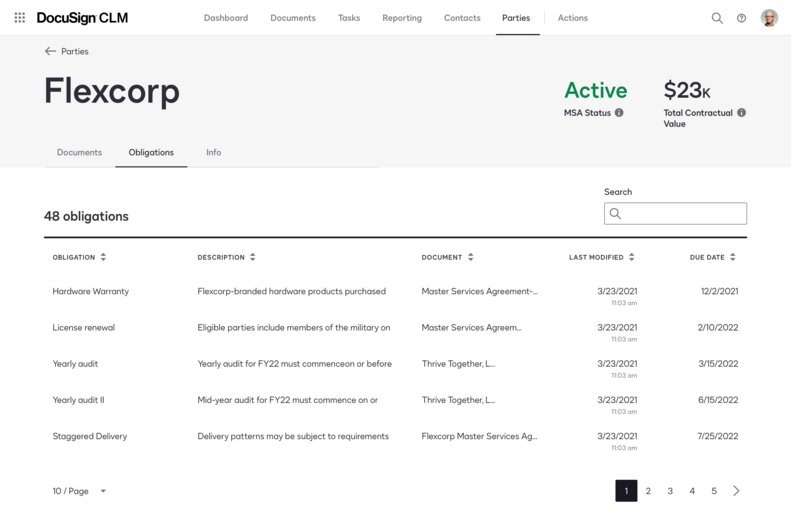Simplifying Contractual Obligation Management
Contract management solutions help streamline the contract lifecycle by automating manual tasks, centralizing contract storage and standardizing contract workflows. The contract process does not end when a contract is signed. For rapidly growing organizations managing a high volume of contracts, the process of tracking and managing contractual obligations is another aspect of the contract lifecycle that can easily overwhelm legal teams tasked with ensuring the business satisfies these commitments.
Managing obligations can be difficult and tedious, especially when trying to identify and track them at scale. Most customers do this completely manually today, or not at all, which leaves them vulnerable to mistakes and oversights that result in revenue leakage, regulatory and financial risk, and missed opportunities for savings.
In this blog we explore common contract obligation management challenges and how contract management tools can help simplify this process even as the volume of contracts increases.
What are contractual obligations?
By definition a contract is an agreement between parties creating mutual obligations enforceable by law. A contractual obligation can come in different forms, including the completion of certain tasks, avoidance of certain acts, delivery of products or services, and the payment of consideration. Parties that fail to fulfill their obligations may face legal consequences. Tracking obligations helps companies stay compliant and reduce their contractual risk.
These obligations can be as straightforward as payment terms (Tenant will pay rent no later than the 5th of every month) or can be as nuanced as detailed ongoing encryption requirements related to data privacy standards.
Common obligation types include:
- Background check required
- Certificate of insurance required
- Compliance terms
- Credits/Penalties/Refunds
- Invoicing and payment terms
- Notice requirements
- Publication of uptime availability
- Restrictive covenants
- Service level commitments
- Termination requirements
The following are contract management mistakes businesses could make without a streamlined way to identify, track and report on contract obligations.
Delivery/compensation errors
Without proper visibility into contract obligations, the company completes a sale but fails to provide the service to the customer in a timely manner. Similar errors could be made regarding the quality or completeness of the service. Along the same lines, the company may also activate the service but fail to collect payment correctly.
Unenforced obligations
Depending on activity that happens after activation, customers may owe the company penalties or fees for additional services, exceeded thresholds or missed obligations. If the company doesn’t have a firm grasp of the contents of its agreements, it will miss these opportunities for additional revenue
Auto-renewal clauses
Without a simple way to track contract renewal dates across the entire contract portfolio, companies can become locked into expensive contracts for longer than desired. An aggregated view of contract obligations with vendors gives the business more time to assess the relationship and enter the renewal negotiation with more leverage to potentially:
- Renegotiate payment and delivery terms
- Lower costs
- Leverage volume discounts
- Increase performance levels
- Address issues with the relationship
Relying solely on manual processes to track contractual obligations (or not tracking them at all) with business partners means the company is exposed to revenue leakage, regulatory and financial risk, and missed opportunities for cost savings.
Introducing Obligation Management for DocuSign CLM
In the DocuSign Agreement Cloud: 2021 Release 2 we are excited to introduce Obligation Management for DocuSign CLM to make it easier for businesses to track and manage their commitments to customers as well as their vendors’ obligations. This new functionality makes it possible to report on and visualize specific obligations within agreements.

With Obligation Management, contract professionals can track important terms and due dates, like notice of termination dates and certificate of insurance requirements to ensure timely fulfillment of obligations and to avoid non-compliance.
So, for example, as a procurement manager reviews a new third party MSA, they can capture that the agreement obligates them to provide this vendor with a 90 day notice of termination. This obligation is then tracked, with a due date and surfaced not only in their standard obligation report, but also on their Party 360 page for that vendor, to help ensure they keep track of this obligation and avoid any fees or penalties associated with non compliance. This streamlined experience helps users stay on top of obligations to their partners, as well as their partners obligations to them.
Effective contract obligation management is also important for other departments managing a high volume of contracts, such as sales contracts, to ensure a business is satisfying its commitments to customers.
Learn more about how you can use DocuSign CLM to track and manage contract obligations.